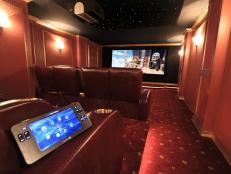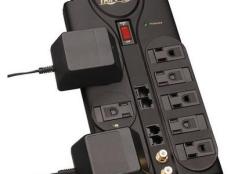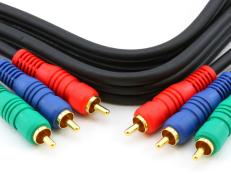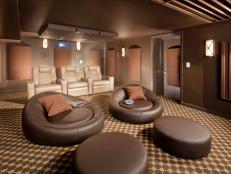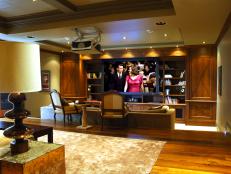Media Room or Home Theater?
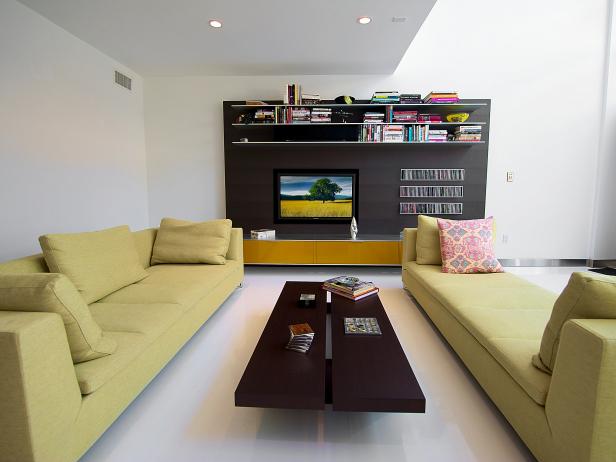
The term media room has evolved into a generic definition for a multipurpose space that is outfitted with a large flat-screen television, surround sound and cozy seating. Friends congregate there to watch the big game. Families go there to watch a movie together. It's party central when guests visit.
"A media room is real life," says Ray Lepper, president, Home Media, Richmond, Va. In comparing a media room to a dedicated home theater designed to replicate a cinema experience, Ray says the flexibility of a media room is more practical for people who want to do more than sit in the dark and watch movies.
"A media room is a more social experience," Ray explains. "You're watching the game, chatting, playing with the kids — and that's OK. What do you do in a theater when someone's talking? You go, 'Shhh ... we're watching the movie.' The lights are down, no talking, no reading. No answering cell phones."
For purists who want a night-at-the-movies ambiance, a home theater is the answer.
But most movie buffs get the theater experience they desire in today's media rooms, says Randy Stearns, president, Engineered Environments, Alameda, Calif. With markedly brighter projectors, large format flat panel displays and advanced digital surround sound formats, the result is "a population that is rather impressed by the experience created in a conventional media room or family room."
Decide whether a media room or home theater format will satisfy your viewing pleasure by taking our quick quiz below.
The Making of a Media Room
Flexible seating: Because a media room is for more than just watching movies, furniture pieces are arranged into conversation spaces that can be "broken down" when moveable chairs are shifted to face the screen. Rather than rows of face-forward seating, media rooms boast comfy sofas, room recliners and inviting loveseats.
Ample screen size: The screen should be large enough so everyone in the room can back up and view it from a good angle. Not sure what size to buy? Ray offers this rule of thumb: First, know your screen size (measured on the diagonal). You should be able to sit back from the television a distance of two to three times that measurement for optimum viewing. "That is large enough that you get a sense of, 'Wow — this is a big deal,'" Ray says.
Sound-absorbent aesthetics: Fluffy sofas, drapery and carpeting help quiet reflections from the sound system. And on the topic of interior finishes, Ray reminds that all controls and media gear can be hidden so the room doesn't look like a tech control center. "Modern remote controls can talk through cabinet doors and even walls," he points out.
Cutting-edge content: The ability to stream movies, music and more from "the clouds" (Internet) has changed the way media rooms are configured. "It's not just a T.V. and DVD player anymore," says Sean Weiner, president, Starr Systems Design, Baltimore, Md. "The quality of the content available now is greater than it's ever been and that content is growing every day."
Designing a Dedicated Home Theater
Cinema lighting: Subtle lighting will preserve the picture quality. While new projection screens perform in higher ambient light conditions, Ray says the idea is still to prevent light from falling directly on the screen. "Windows and a light over a pool table or bar — that's a problem," he says. Remote control dimmers on lights are ideal.
The screen/sound/room equation: "When you go to the movie theater, there is a sense of anticipation when the lights go down — there's a lot of magic going on there," Ray relates.
Sound is more than half the experience. But Ray says many people cut their budget short and focus mostly on the screen. He suggests taking your budget and dividing it into three equal parts for the screen, sound and room. "No one jumps at a picture of a gun, they jump at the sound," he remarks.
Setting the mood: Equally important to the cinema experience is comfortable seating and an acoustic environment that absorbs sound. Seating is generally arranged in rows, facing forward to replicate a movie theater. This way, everyone fully experiences the impact of the sound and picture. "A private cinema re-creates a precise reproduction of what the artist, the director and the sound engineer (of a film) intended," Ray sums up.
Questions to Ask Yourself
- Do you plan to entertain while watching or listening to media?
- Will you use the media system for purposes other than watching movies (such as gaming or streaming music for a party)?
- Is flexibility important to you?
If you answered yes to these questions, a media room is the best fit.
- Do you want to mimic the cinema experience at home?
- Does your home contain a space that can be dedicated solely to movie-watching?
- Do you already have a space in your home where family gathers socially to watch television or play games?
If you answered yes to these questions, you should talk to an electronic systems professional about home theater installation.






